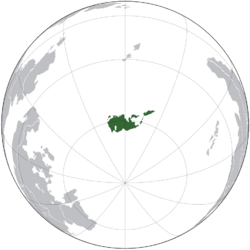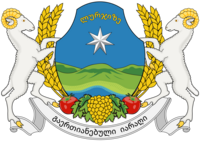Lurjize
Republic of Lurjize ლურჯიზის რესპუბლიკა | |
|---|---|
Motto: გაერთიანებული იარაღი Gaertianebuli Iaraghi (United in Arms) | |
 | |
| Location | Southern Ocean |
| Capital and largest city | Paluri |
| Official languages | Lurjizean |
| Recognised national languages | Lurjizean Creeperian Spanish |
| Ethnic groups (2010) | ??% Lurjizeans ??% Creeperans |
| Religion (2010) | ??% Catholic |
| Demonym(s) | Lurjizean |
| Government | Unitary semi-presidential republic |
| Anri Akhalaia | |
| Tengiz Biniashvili | |
| Legislature | National Congress |
| Independence from Creeperopolis | |
• ??? | ??? |
| 14?? | |
| 1918 | |
| Population | |
• 2021 estimate | 9.4 million |
• 2010 census | 9.5 million |
| GDP (nominal) | 2014 estimate |
• Total | ₵48.4 billion |
• Per capita | ₵5,100 |
| Gini (2014) | 37.4 medium |
| HDI (2017) | high |
| Currency | Lurjizean Viri (LUV) |
| Time zone | AMT+3 to +4 |
| Driving side | left |
| Calling code | +507 |
Lurjize, officially the Republic of Lurjize (Lurjizean: ლურჯიზის რესპუბლიკა; transliteration: Lurjizis Resp’ublik’a), is the sole nation of the Lurjizean landmass located in the Southern Ocean between mainland Sur and the San Carlos Islands.
Contents
Etymology
It is believed that the modern name Lurjize stems from the Lurjizean word ლურჯი (lurji), meaning 'blue.' One running theory is that this was appended onto the Lurjizean word for 'sea', ზღვის (zghvis), but this was shortened over time until it became obsolete by the time of independence from Creeperopolis. Under Creeperian occupation, Lurjize was known as San Esteban, with the landmass being referred to as the Saint Stephen Islands (las Islas de San Estefano). However, even during the roughly five centuries of Creeperian rule, the name Lurjize was widely used amongst the non-Creeperan population.
History
Early settlement
The earliest definitive trace of human activity in the Lurjizean landmass can be traced back to the migration of the Proto-Creeperans from present-day Creeperopolis due to food insecurity caused by the region reaching its carrying capacity before the advent of agriculture in Sur. The extent of which the Proto-Creeperans were a seafaring people are unknown, as well as whether they were aware of the Lurjizean landmass or not. However, starting in around 3,500 BCE, archaeological records suggest that Proto-Creeperian immigration to the Lurjizean landmass began, with this continuing for several centuries. Modern DNA analysis suggests that the Proto-Creeperans would continue migrating east, eventually reaching the San Carlos Islands. Lurjizean historians believe that contact between the indigenous peoples of Lurjize and the San Carlos Islands would continue until Creeperian colonization of Lurjize beginning in the 15th century, though there is no evidence to suggest that later Lurjizean states exchanged language with San Carlos' indigenous population.


